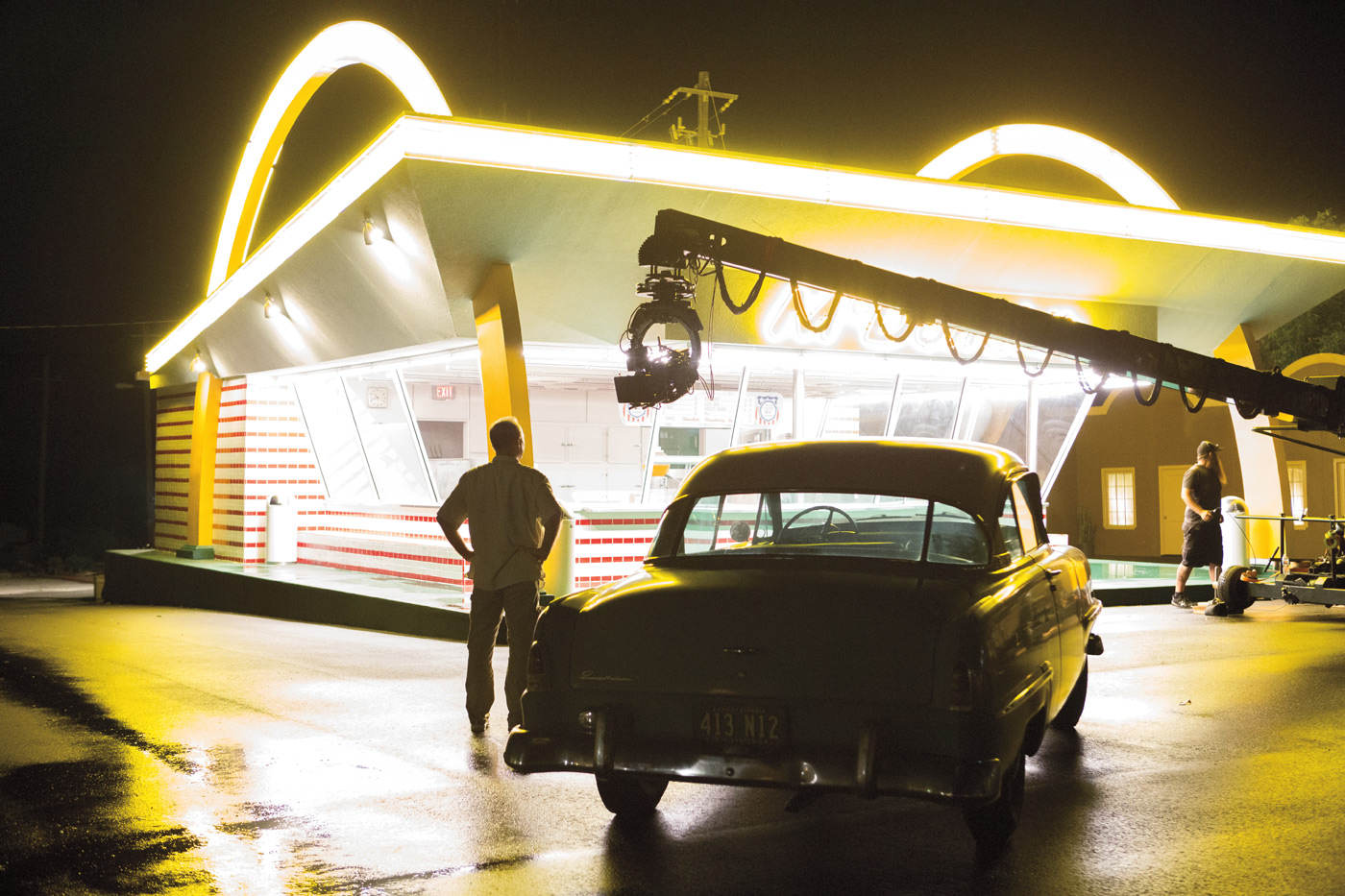John Schwartzman, ASC, captures Michael Keaton’s “supersized” performance in the story of McDonalds’ founding.
While heading home one night from San Bernardino to Illinois, Ray Kroc (Michael Keaton) makes a fateful decision. He pulls off to the side of a Phoenix highway, transfixed by a band of golden yellow that appears in a reflection across his windshield. The world will now easily recognize the reflection as the famous “Golden Arches.” But in the early 50’s that iconic swath of yellow was not yet a mass-market symbol. And as writer/director John Lee Hancock observes about how entrenched the symbol has become in our culture: “We’ve screened the movie for people who haven’t been to McDonald’s in years, and they text me pictures of themselves on the way home in the drive-thru line.”
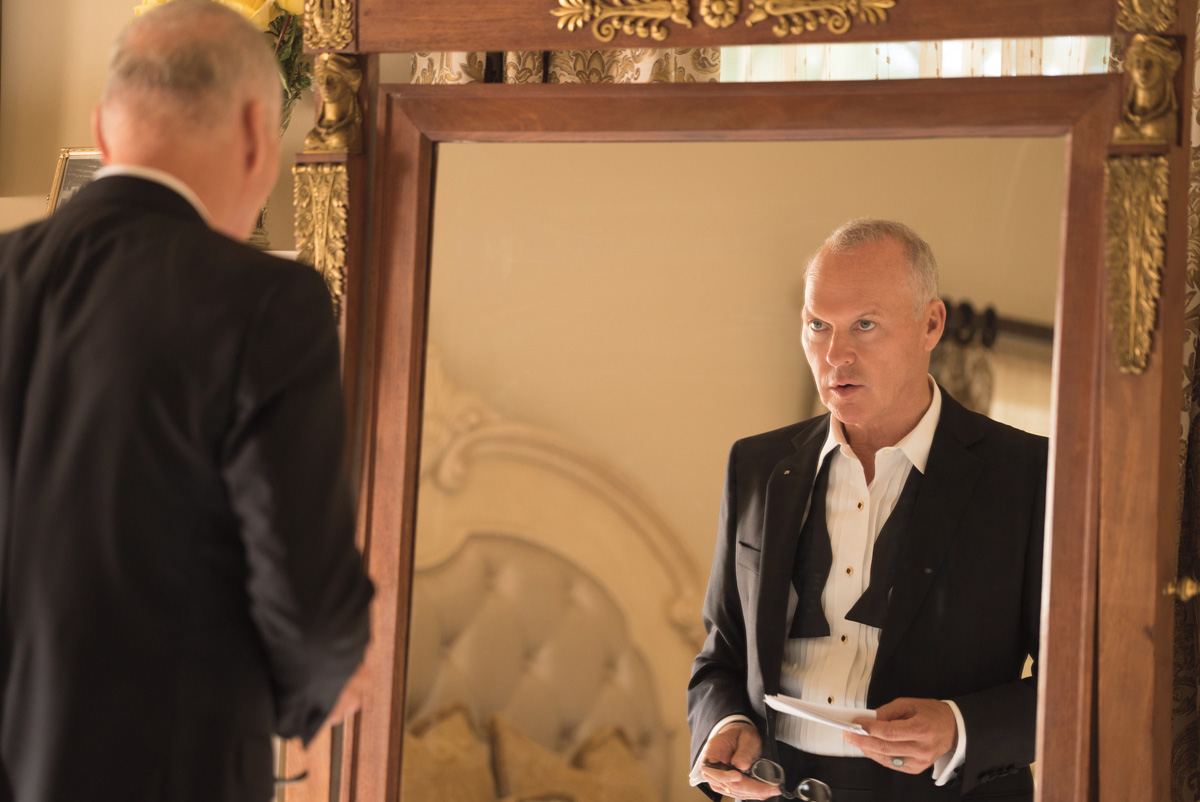
The Founder tells the story not only of how Kroc wrestled the company away from brothers Dick and Mac McDonald, but how he took their original idea of cooking a brief menu in an assembly line and essentially created the fast food industry.
Hancock, the director of Saving Mr. Banks and The Rookie, wasn’t immediately sure he was up for the biopic. “I got the script, and I thought, ‘I just finished a movie where I did P.L. Travers and Walt Disney and one about Jimmy Morris. Do I really wanna do another true life story?’ But I realized this is really more of an origin story of the fast food industry, and McDonald’s in particular.”
John Schwartzman, ASC, who had shot Banks and Rookie, and production designer Michael Corenblith, along with costume designer Daniel Orlandi (both of whom had worked those films plus Hancock’s The Alamo and The Blind Side) reteamed with Hancock. (The unit typically includes editor Mark Livolsi, who was busy cutting The Jungle Book). “It’s like bringing the rock band back together,” Schwartzman smiles. “John Lee and I are very good friends, and we’re even better collaborators.”
Filming took place in Atlanta, and Schwartzman brought three of his own frequent team members – A-camera Operator Ian Fox, SOC, 1st AC Dan Ming and DIT Brook Willard. [For the occasional B-camera/Steadicam shot, operator Bob Gorelick, SOC, now an Atlanta resident, would join the group.]
With the film’s modest budget and short work period, Schwartzman was concerned about filling out the team with qualified technicians. “If you can’t promise people six months of work, it’s hard to get painters and plasterers, but also electricians and grips that are any good, because they’re all doing Captain America: Civil War or other big pictures,” he laments. Fortunately for Schwartzman, seasoned local gaffer Dan Cornwall was in-between projects. “As soon as I heard John was doing it, I was interested,” Cornwall recalls. “Plus, when we all first met John Hancock, he told us, ‘I just want to make sure everybody realizes my number-one goal is your quality of life, every day.’ When did you ever hear that come out of anybody’s mouth?!” he laughs.
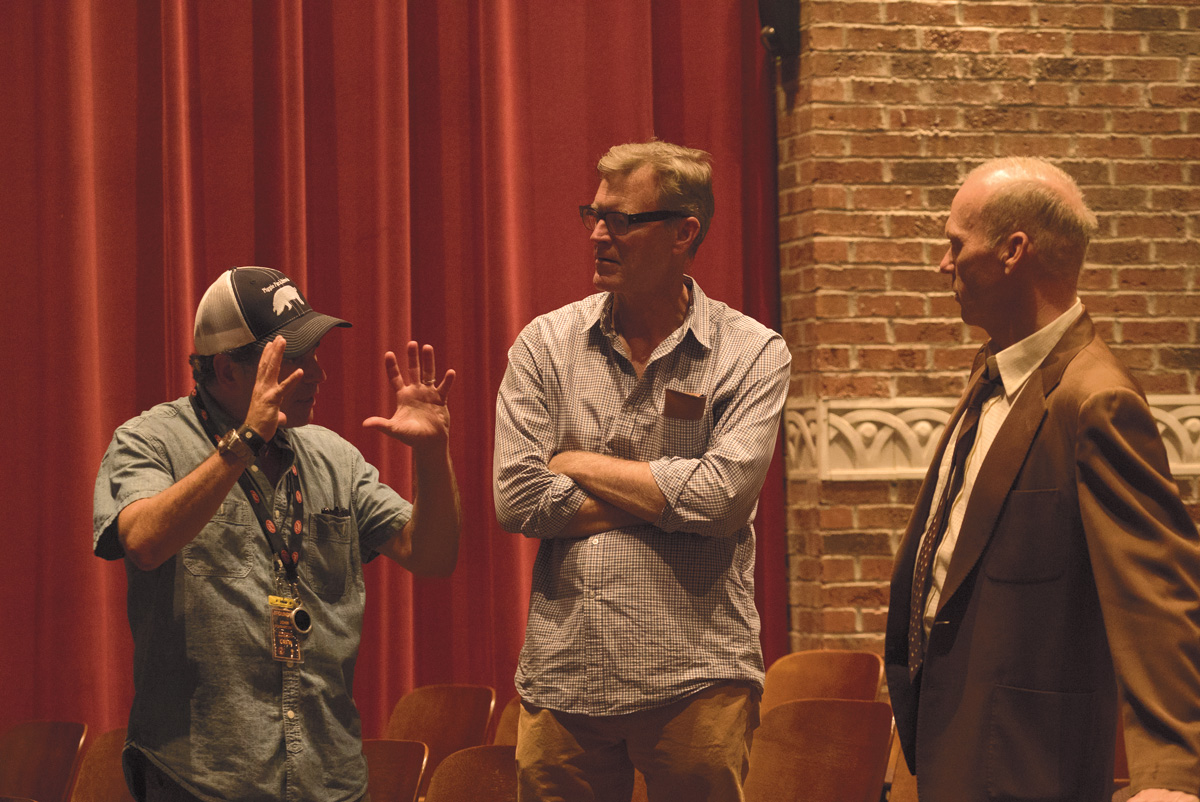
Neither Schwartzman nor Hancock had shot much in the digital format – and neither thought it appropriate for a period film like The Founder, which takes place mainly in 1954. But they both quickly took to the ARRI ALEXA, and it’s deft handling of low light levels. For a small bank-office location, Schwartzman wanted to avoid hard light, so he had Cornwall set several 18K HMI’s outside each window directed into Ultrabounce. “When I got there on the day, I realized I didn’t even need it,” the DP recounts. “I turned the camera on, and I was getting the same quality of light without it.”
But the digital sensor did pose an issue for the period costumes. The patterns Orlandi had designed for Keaton, commonly seen in the 1950s, produced moiré patterns. “The sensor is a grid of dots, and dots don’t like patterns on clothes,” Schwartzman continues. “I love the way his plaid jacket looked to my eye, but when I put it on camera, it suddenly came alive,” forcing Orlandi to quickly find substitutes. “We camera-tested all the costumes,” Hancock adds. “We would set ‘’em up, dolly in, zoom, try to do anything we could to get them to moiré – and they would come up clean; then we’d be on set, and it would happen. The only true test was to put on every single lens you’d ever use on that garment, move in, out, which would make your camera tests about a week long.”
As has been their custom with past film projects, Schwartzman and Hancock shot anamorphic, which required longer lens choices – a 40 mm where a 20 mm might otherwise be used. “The magnification of anamorphic is much more akin to the human experience of how we see the world,” Schwartzman explains. “We also wanted it to look like how the lenses looked in the 1950s and 60s – a little softer, without as much contrast, and not as sharp, edge to edge.”
As he did for Jurassic World (ICG June 2015), where he turned to Panavision’s Dan Sasaki to detune a set of Primos for a 1970s Zeiss look, for The Founder, Schwartzman had Sasaki detune a set of G-series anamorphics to look like the DP’s preferred C-series.
Ming, who calls Sasaki “a genius,” was able to alter the lenses, “to the exact amount we needed. We did tests, with light, medium and heavy detuning on all focal lengths, and decided to go for mediums for most of the lenses,” though backing off some for wider lenses. “Dan’s alterations allowed us to drop the contrast, and get things like veiling glares, which fit the period.”
Whenever possible, Ming pulled focus using Preston Cinema’s new Light Ranger 2 (offered by Howard Preston as a test run). “It’s an infrared LED-based system, with a wide beam, broken into different zones,” the AC adds. “So you get simultaneous readings across the whole field of view,” tied in to Preston’s FI+Z hand unit.
The detuning also allowed Hancock to include more lens anomalies that would mimic a filmic period look. “It was never about fixing what the lenses did,” Willard offers. “We would try and find shots sometimes where the flaws that had been engineered into these lenses would show up and let it stay there.”
While the detuned prime lenses were used for most of the film, for the later years, Hancock says he didn’t mind, “if it got sharper” as Kroc’s metamorphosis, from door-to-door milkshake multimixer salesman to corporate executive “is complete.” For that part of the film, Schwartzman used unaltered Panavision G Series zooms, 70-200 mm and the new LWZ-2 36-78-mm 2:1 zoom.
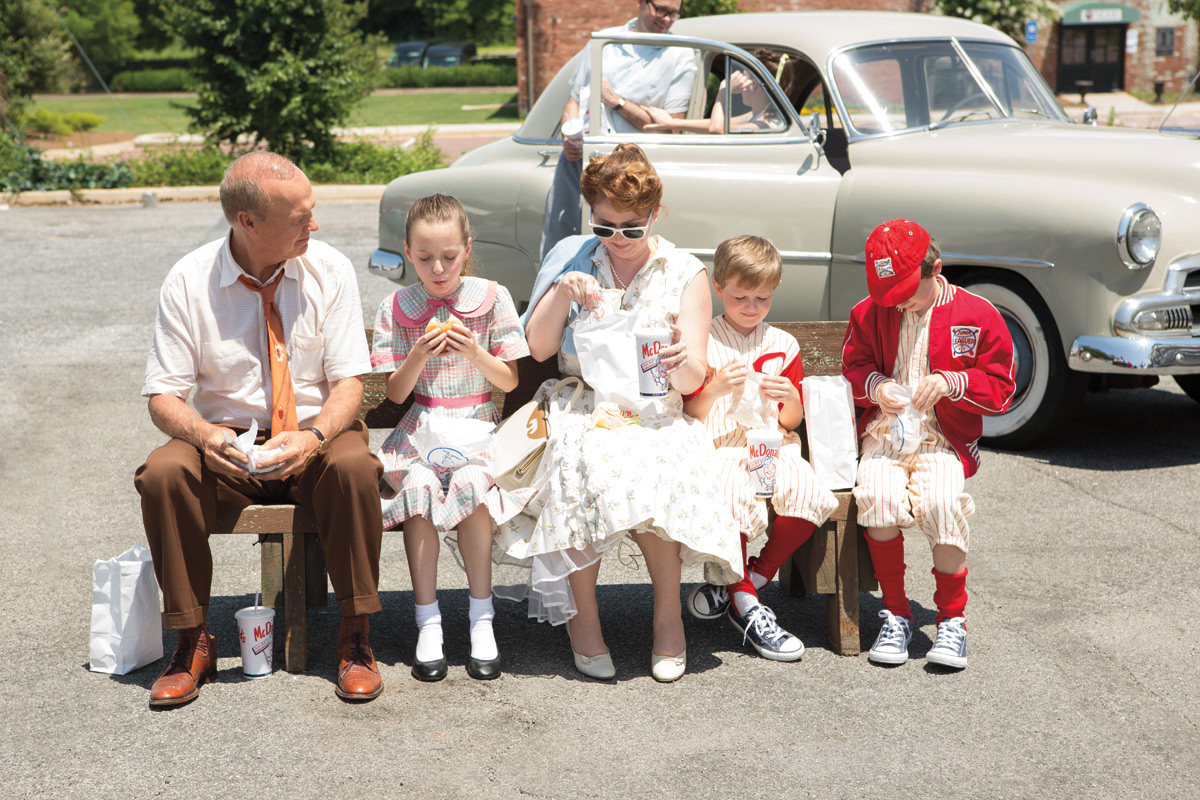
Fox has operated 15 films for Schwartzman, beginning in 2002 with Hancock’s The Rookie when Panavision cameras, dollies, and optical viewfinders were the tools at hand. “Digital monitors on set have evolved so significantly in quality that I’d rather operate looking at [the monitors] than through a digital eyepiece, even though that means sacrificing the intimacy I’ve been accustomed to with an optical viewfinder,” he observes. “That was the most significant change working on The Founder.”
The operator also tried KFX Technology’s new Aurora Remote Head, which the company offered him to test for most of the shoot. The unit was placed on the dolly or crane, with Fox standing adjacent with the Aurora’s control unit on a tripod, viewing the imagery on a high-resolution monitor.
“I stand as close to the camera as I can, which helps maintain the connection with the actors,” he explains. “Technocrane, Libra head, and KFX were all great partners in helping me develop a new relationship with the digital eyepiece experience.”
As per Hancock’s vision, the look of The Founder is naturalistic. Or as Schwartzman concisely notes: “What you see in the frame is how it looked on set.” Willard confirms that, “it was never ‘make this look old,” the DIT offers. “We weren’t trying to build a period piece in the computer – it was already there in front of the lens.”
Though the McDonald’s corporation didn’t cooperate or aid the production, they didn’t impede, either. But, adds Corenblith, “we were a little fuzzy on how McDonald’s was going to be reacting to all this. So in terms of fair use, the safest place to be was to do everything within our power to get things as correct as possible from an archival perspective,” which meant the designer poring over historical records and images with Hancock and Schwartzman.
For the various carhop drive-ins Kroc visits in the beginning of the film – including that of the McDonald brothers – the designer tracked down existing structures in the Atlanta area. Practical sets, like the McDonalds’ offices and Kroc’s “Prince Castle Sales” interior, were built on stages at EUE Screen Gems Studios in Atlanta. But it is the carefully reproduced McDonald’s restaurants – the brothers’ original “Octagon” carhop and true Golden Arches sets – built on location in Newnan and Douglasville, GA, which are the visual showstoppers.
Corenblith says he researched countless photographs of Golden Arches-style McDonald’s (before most were converted to Mansard roof-style structures around 1970), as well as original blueprints and other documents found online and in a museum adjacent to the brothers’ original San Bernardino location. “We also studied the only existing Golden Arches restaurant, in Downey, California,” he notes.
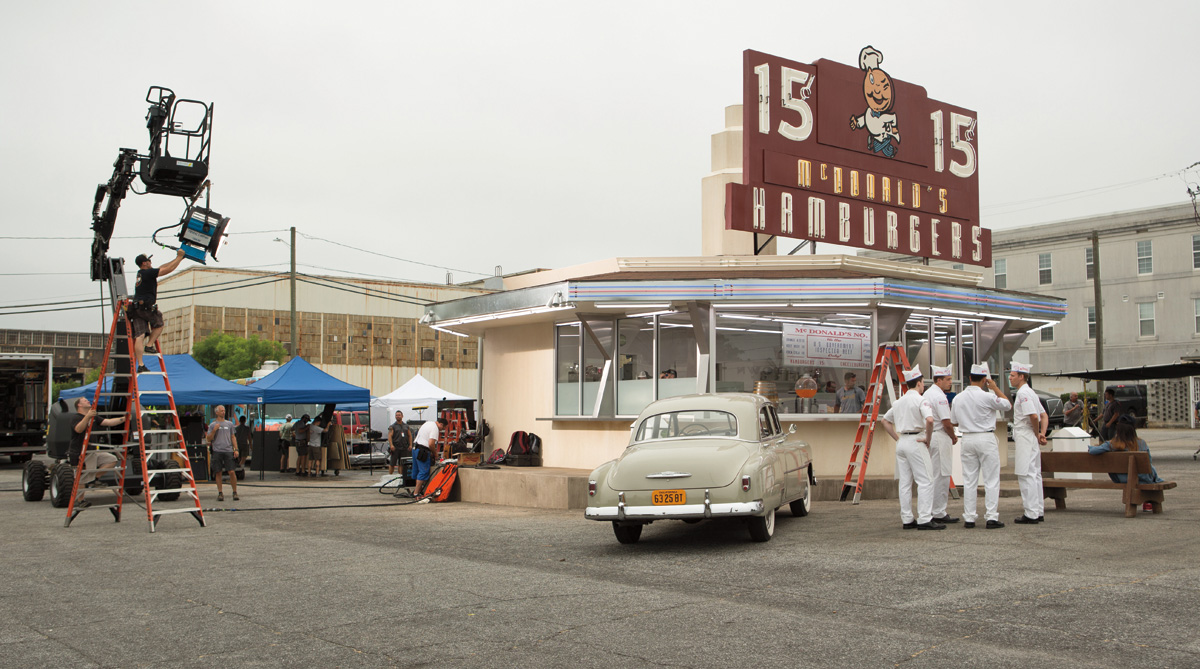
Local building officials insisted the structure be built to code, which meant only one, restaurant set could be built; with dressing and VFX extensions, the single structure played as eight different locations. “They said if people are pretending to serve food, it has to be built to code,” Schwartzman recalls. “That’s the great myth about shooting in rebate states; sometimes you’re not necessarily saving so much money.”
The built restaurant/set was fully functional, with working mechanical/electrical systems, grills and fryers. Extras were even versed (via original training manuals) to perform different functions via the McDonald brothers’ ingenious “Speedee System,” which is detailed in a complex flashback scene that included an overhead camera, and choreography by local hip-hop artist Kiki Ely, because as Hancock explains, “we wanted it to play like a Busby Berkeley musical.”
Photographing in the tiny, to-scale McDonald’s structure, would have been impossible if not for extensive preplanning between Schwartzman and Corenblith. Working with Foamcore models, the pair devised a system that allowed the kitchen action to be shot from outside the restaurant, via removable windows.
“We’d take the windows out of one side, so we could place two cameras out there, and get tighter and wider coverage at the same time,” Fox recalls. “Then we’d do a turnaround – put all the glass back in and take it off on the other side and get our coverage. It was pretty efficient.”
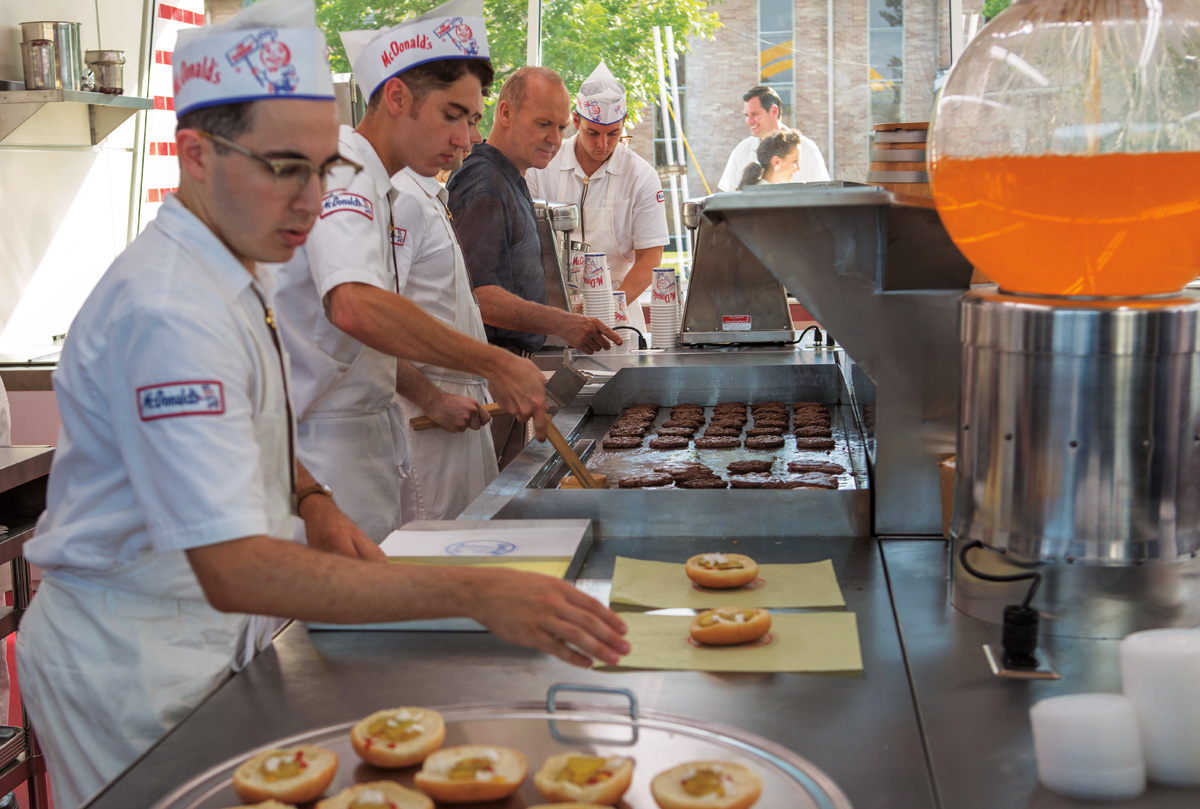
Lighting the interiors of the restaurants was made equally efficient by Cornwall’s use of Quasar Science Q-Line S Switch Linear LED Lamps. “They have an LED tube that’s basically a replacement tube for four-foot fluorescents,” the gaffer explains. “There’s a little switch on each that allows you to quickly switch from daylight to tungsten. We had 55 two-tube fixtures, which run off 120 volts, bypassing the ballast. You could just grab a couple of ladders and quickly go from daylight to a nighttime look. It was a real game changer.”
As noted above, the key moment when Kroc gets his first eyeful of a Golden Arches-style McDonald’s was “the only time we have any kind of saturated color – so that it would stand out,” Cornwall describes. (The gaffer actually found a close match to the neon yellow for another shot, via a gel – Storaro Yellow, formally VS Yellow).
“That was originally going to be a day sequence,” Schwartzman remembers. “But I got out there one night to test the neon, and I told John Lee, ‘We gotta make this a night scene. [The arches] will play like a beacon, a little jewel in the night. Also I love reflections – because you can see two different things at the same time – what he’s looking at and his reaction.” Hancock used the shot as a tease for the audience, before offering a low-and-wide reverse showing what Kroc is beholding. “I wanted to just give every hint – anything we could do to tease that moment,” the director adds.
As time passes, the look of the film also shifts – from dingy to bright and warm – “a visual metaphor,” Corenblith describes, “for the shift from the McDonald brothers’ individually operated carhop culture to Kroc’s development of mass-market clones. It represents the change in post-War America, that moment of optimism and opportunity, which is really Kroc’s religion.” Adds Hancock: “America had come through World War Two, and we felt like we deserved everything, and we wanted it now.”
“What I find so iconic about this movie,” Schwartzman concludes, “is that in the beginning, you sort of root for Ray Kroc, and by the time it’s over, you don’t know whether you should feel bad about rooting for him. Either way, I think McDonald’s will sell even more hamburgers than they already do after [the film] comes out.”
by Matt Hurwitz / photos by Daniel McFadden
